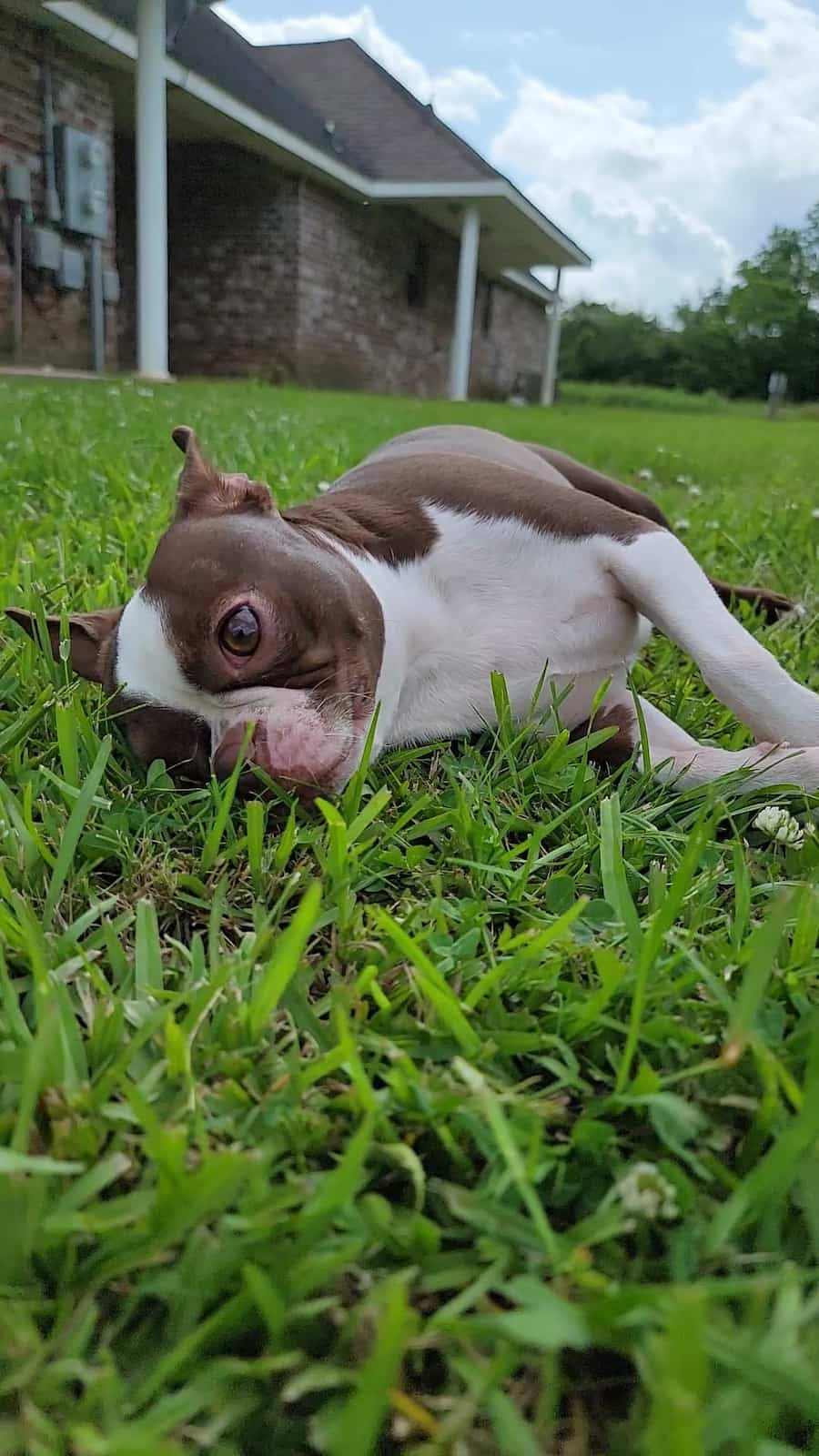The Boston Terrier dog breed is known for its adorable triangle ears that stand up straight; however, some Boston Terrier owners often wonder why their new puppy’s ears are floppy.
There is nothing to worry about if your puppy’s ears are not standing up just yet. Although it can be concerning for owners, there are multiple reasons why this can happen.
Your Boston Terrier’s ears may not be standing up straight because each Boston Terrier is different. Typically their ears will begin to stand on their own between 6–20 weeks. Although, if their ears have not stood after 12-15 weeks, there may be a chance that your Boston Terrier has a health problem or is perhaps not purebred.


Since puppies are born blind and deaf they must develop the most critical aspects of their bodies first. Missing cartilage or pinna (the flap of skin that is covered by fur and composed of muscles that are attached to the cartilage) is the cause of Boston Terrier puppies having floppy ears at birth. The cartilage in the ear increases significantly after development in areas such as sight and hearing.
Patience is key when waiting for your Boston Terrier’s ears to become straight. In most cases your dog’s ears will be completely fine; however, if it is taking a long time for their ears to stand up, having your dog examined by a vet is the best option to find out what is going on with their ears.
General appearance of Boston Terrier ears
The general appearance of Boston Terrier’s ears includes a distinct triangle shape.
Disclaimer: This post may contain affiliate links. We only recommend high-quality products that are used and recommended by real owners. If you use these links to buy something we earn a small commission.
The ears are typically firm and somewhat large in proportion to the head and body size. They are set well apart and are tilted directly forward. The inside of the ear is straight whereas the outside has a slight outward curve that runs back to the neck.
According to the AKC standard for Boston Terriers, their ears are described as “carried erect, either natural or cropped to conform to the shape of the head and situated as near to the corners of the skull as possible.”
Although Boston Terriers can all look different, purebred Boston Terrier’s ears will normally have this distinct appearance as their floppy puppy ears begin to stand up.

Since Boston Terrier’s ears can be slightly different in areas such as color or structure, even with the distinct appearances listed previously, their ears still play a critical role in the facial expressions that each Boston Terrier makes.
Each time a Boston Terrier’s ears tilt a certain direction, they are expressing themselves and their emotions, concerns, etc. This in turn makes their faces portray different expressions. This attribute is very unique and helps owners to decipher how their dog is feeling.
Reasons why your Boston Terrier’s ears aren’t standing up
There are multiple reasons why your Boston Terrier’s ears may not be standing up. Two of the most common reasons are ear infections and collagen deficiencies. When a Boston Terrier gets an ear infection oftentimes one or both ears become floppy; this is frequently accompanied by a bad odor, scratching, and redness. Collagen deficiency is a medical condition that can cause floppy ears solely because the ears are unable to stand on their own.
After talking with Boston Terrier Owners there are a large number of them who are concerned about their dogs’ ears not standing up; however, in a lot of cases the dogs were not purebred Boston Terrier. Not having straight ears is very common with mixed breeds however and should not be a huge concern.
Oftentimes Boston Terrier’s who do not receive the care they need have ears that may never lift. This is due to cases of malnutrition, illness, fungal infections, parasites, and many other causes.
When a Boston Terrier’s ears don’t ever stand up it is called drop ears, meaning they drop down instead of standing upright.
Sometimes female dogs’ ears will take longer to stand upright than their male counterparts.

How to straighten my Boston Terrier’s ears faster
There are many ways that Boston Terrier owners have tried to straighten their pups’ ears faster; however, talking with your vet is one of the best ways to find out what is right for your dog in particular.
95% of the time just waiting until they grow more will do the trick and your dog’s ears will stand up on their own.
Owner tricks and tips to help your Boston Terrier’s ears stand up faster.
- Making sure that your pup has plenty of proper chew toys. The chewing action helps strengthen the muscles needed for their ears to stay up.
- Add some food to your Boston Terrier’s diet that increases the amount of calcium it gets such as a tablespoon of plain yogurt or no-fat cottage cheese. Try this for about 3 weeks.
- Some owners will get their Boston’s ears cropped to help them have a more straight look. Before you do that please read this article.
It is typically safe for dogs to consume yogurt and cottage cheese; however, this does not mean that your dog will not have trouble digesting lactose. Talking to your vet is the best option for deciding whether or not to participate in these diet changes.
Other owners suggested an overall wholesome and nutritious diet that includes certain supplements. They found that their Boston Terrier’s ears stood up very fast after weeks on this specific diet.
It was specifically recommended to add glucosamine, a natural cartilage-building amino sugar to a Boston Terrier’s diet to build the cartilage strong enough to hold the ears straight.
As cartilage strengthens, the pinna in the dog’s ear begins to stand straight. By developing a consistent nutritional diet for your dog, changes in cartilage strength may become noticeable and the ear may begin to straighten.
Tip: Breathe right strips work great because they are sturdy yet lightweight!
What do Boston Terrier’s ear positions mean?
Ear position can tell us a lot about how our dogs are feeling. Boston Terriers specifically have very unique communication signals that often involve the ears.
As a Boston Terrier’s ears gain more cartilage and begin to stand straight they will become very expressive. By being able to move their ears in certain ways they not only can pick up on certain sounds but are also able to inform their owners of what they are feeling.
Some common communication signals that Boston Terriers may use are:
- Relaxed/neutral
- Playful
- Anxious/upset
- Aggressive
- Fearful
- Intelligent
- Proud
Your Boston Terrier may indicate their emotions and feelings by placing their ears in multiple positions to show what they are feeling. Although, each Boston Terrier is different and you must learn what your own Boston Terrier is communicating to you.
6 Reasons Why Your Boston Terrier Stares at You
Common ear positions and the emotions related to them:
Ear Position | Emotion |
Flattened | Nervous, fearful, anxious, submissive, lack of confidence |
Turned | Nervous, fearful |
Forward | Playful |
Airplane | Happy/excited |
Forward to Flat | Lack of attention |
Moving | Looking for information (receptive) |



How to clean my Boston Terrier’s ears
Boston Terriers are less likely than other breeds to obtain ear infections due to their perky ears that promote good airflow throughout the ear canal; however, there are still opportunities for issues such as ear mites and inflammatory problems.
If a Poms’s ears are neglected they can easily build up excess hair and ear wax in the ear canal that will block to flow of air and increase the likelihood of your dog having chronic ear infections.
Cleaning your Boston Terrier’s ears is a crucial step in avoiding any potential issues that could arise. There are several steps to take that will ensure your Boston Terrier’s ears stay clean and healthy!
Two main ways to maintain your Boston Terrier’s ear health are cleaning the ear gently with a mild solution (canine ear cleaning solution) and cotton balls as well as trimming your Boston Terrier’s ear hair.
It is also helpful to squeeze veterinary-approved ear cleaner into your dog’s ears and massage the ear gently for 30 seconds to dislodge any buildup from the ear canal; however, do not let anything but the cleaning solution touch the dog’s ear to avoid causing more bacteria.
It is not recommended to use peroxide or cotton swabs in your dog’s ears. This can cause damage to certain areas in the ear as well as inflammation and further infection.
You may be able to tell when your Boston Terrier needs its ears cleaned. A healthy ear should be light pink with no smell and little wax if any.
If you notice a strange color, a mild odor, or see that your dog is scratching its ears or shaking its head, it may be time to clean its ears. It is a good idea to ask your vet how often you should be cleaning your Boston Terrier’s ears because each dog differs.
You may also want to check your Boston Terrier’s ears often for:
- Wax buildup
- Mites
- Hair loss
- Redness
- Ear discharge
- Bad Smell
Boston Terrier ear infection, mites, or allergies?
It may be difficult to determine whether your dog has allergies, an ear infection, or mites. All of these issues first occur with the symptoms of whining, head shaking, and scratching. Since Boston Terriers in particular are very prone to normal allergies, it is sometimes difficult to determine why they are scratching.
You may notice your Boston Terrier is beginning to act strange, this could be due to an outer ear infection caused by the many issues listed previously; or an inner ear infection that occurs when the outer ear infection is left untreated.
Causes of ear infections in Boston Terriers:
- Bacteria in the ear
- Yeast
- Fungus
- Ear mites
- Foreign objects lodged in the ear
- Trauma
- Tumors
- Polyps
Symptoms specific to mites include head and ear scratching, dark/crumbly reddish-brown discharge, dried blood, inflammation, and infections. Scratching at the skin is oftentimes an issue because if your dog cuts the skin more infections can occur.

Boston Terriers are prone to a skin allergy called “atopy,” where the ears are heavily affected. Symptoms typically start around 1–3 years old and can get worse every year. You may notice your Boston Terrier licking their paws, rubbing their face, or developing ear infections more often. There are many treatment options available for atopy and it is normally easily treatable!
You may also notice your Boston Terrier cannot hear as well as usual and is perhaps dizzy or nauseous. If you begin seeing any of these symptoms it is recommended for you to get your Boston Terrier to the vet right away.
Pro Tip: If you are not able to get a hold of a vet near you, or you want to avoid an unnecessary ER trip, there are online resources that you can turn to. Here is our best recommendation:
Pawp: a 24/7 digital clinic for pets that connects you to an experienced vet
Why we love it:
🐾 Answers 24/7! 🐾 No waiting! 🐾 Get Answers Online with Local Vets! 🐾 Quick Response Time! 🐾 Easy Sign UP!
Try Pawp 7 Days For Free
A veterinary clinic may prescribe ear drops or cleaning solutions that will help rid the ears of infection or a solution to treat the skin allergy. If your dog has an infection only in one ear, be careful to avoid spreading the infection to the other ear while using certain cleaning methods.
Long-Term Complications of Ear Infections
Typically ear infections do not go away on their own. It is important to get your dog checked by a veterinarian immediately if you notice an ear infection has gone on too long.
If the infection is left untreated it may become even more difficult to get rid of the infection. An untreated ear infection can lead to serious long-term complications or may result in your dog needing surgery.
Some signs that your Boston Terrier’s ear infection has been left too long include symptoms of:
- Scratching
- Rubbing at the infected ear
- Discharge
- Odor
- Redness inside the ear
- Swelling of the ear canal
- Crusts
- Scabs
Long-term complications can arise if the ear infection is left untreated. Some more serious issues include hearing loss, balance issues, deafness in the infected ear, or in extreme cases, Horner’s syndrome, which is a condition that causes a loss of stimulation in the nerves surrounding the eyes.
While we strive to give the most accurate and helpful information about your pet’s health that we can, this article is meant to be informational only and not medical advice. Never disregard, avoid or delay in obtaining medical advice from your veterinarian or other qualified veterinary health care provider regardless of what you have read on this site or elsewhere.



